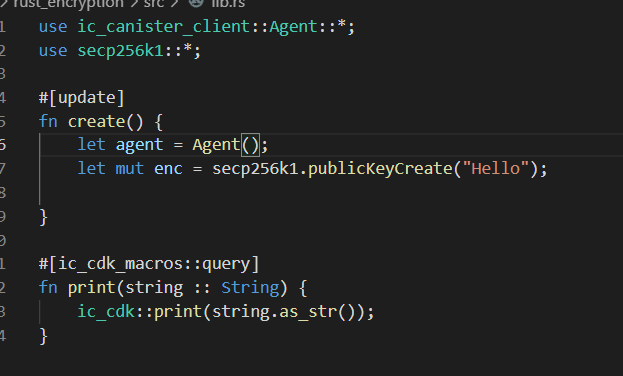Overview
In the Internet Computer ecosystem, a library that is used to make calls to the IC public interface is called an agent. An agent has a few key responsibilities, which make it convenient to work with in your language of choice.
在互联网计算机生态系统中,用于调用 IC 公共接口的库称为代理。 代理承担一些关键职责,这使得您可以方便地使用您选择的语言进行工作。
If you have a canister running, either on your local machine or live on the Internet Computer, you will have two main ways to interact with your canister smart contract. You can talk to the canister using the v2 API using an agent that follows the interface specification, or you can use the canister's HTTP interface.
如果您有一个容器正在运行,无论是在本地计算机上还是在互联网计算机上运行,您将有两种主要方式与容器智能合约进行交互。 您可以使用遵循接口规范的代理,使用 v2 API 与容器进行通信,也可以使用容器的 HTTP 接口。
Available agents
This section of the docs covers the following agents, ordered by languages:
- JavaScript / TypeScript
- Rust
In addition to those, there are several other community-supported agents:
- .NET
- Dart
- agent_dart by AstroX (supports mobile development with Flutter)
- ic_dart_tools by Levi Feldman
- Go
- Java
- ic4j-agent by IC4J (supports Android)
- Python
- C
- agent-c by Zondax (C Wrapper for IC Rust Agent)
- Ruby
If you're interested in building an agent in another language please reach out to us via https://dfinity.org/grants.
What an agent does Structuring data
A call to the Internet Computer can take two common forms - an update or a query. The agent submits a POST request to /api/v2/canister/<effective_canister_id>/call, and includes the following components:
对互联网计算机的调用可以采用两种常见的形式 - 更新或查询。 代理向 /api/v2/canister/< effective_canister_id>/call 提交 POST 请求,并包含以下组件:
- request_type
- Authentication
- sender, nonce, and ingress_expiry
- canister_id
- method_name
- request_id - required for update request type calls
- arg - the rest of the payload
By knowing the Candid interface of the canister, the agent will assemble the "arg" with data from the client application, ensuring it matches the Candid interface for the method it will be calling. All of the above components are then assembled into a certificate, which is transformed into a CBOR-encoded buffer.
通过了解容器的 Candid 接口,代理将使用来自客户端应用程序的数据组装“arg”,确保其与将要调用的方法的 Candid 接口相匹配。 然后将上述所有组件组装成证书,并将其转换为 CBOR 编码的缓冲区。
For update requests, the agent also hashes the rest of the fields, and passes it in as a unique request_id. That request_id is used for polling while the IC reaches consensus on the update.
The agent takes the CBOR-encoded certificate and attaches it to the body of the POST request. The canister will work on that request asynchronously, and then the agent can begin polling with read_state requests, until the canister response is ready.
Decoding data
Once the data has been returned from the IC, the agent takes the certificate from the payload and verifies it. The certificate can be verified as genuine using the public rootKey of the NNS subnet. The network will respond with a CBOR-encoded buffer, which the agent can then decode, and transform into a useful structure using semantic language-specific types. For example, if the type returned from the canister is text, that will get turned into a JavaScript string, and so on.
Managing authentication
Calls to the Internet Computer always need to have a cryptographic identity attached. That identity will either be anonymous or authenticated, using a cryptographic signature. Since identities are required, canisters can use the identity attached to a call to decide how to respond to that call. This enables contracts to use those identities for other purposes.
Accepted identities
The IC accepts calls using the following types of signatures in identities:
- Ed25519 and ECDSA signatures.
- Plain signatures are supported for the schemes.
- Ed25519 or ECDSA on curve P-256 (also known as secp256r1).
- using SHA-256 as a hash function.
- using the Koblitz curve in secp256k1.
When encoding these identities as a principal, agents attach a suffix byte, indicating whether the identity is self-authenticating or anonymous.
A self-authenticating identity using one of the above curves will have a suffix of 2.
While the anonymous identity is a single byte 4. It resolves to "2vxsx-fae", in its textual encoding.

Integrating external agents with the IC